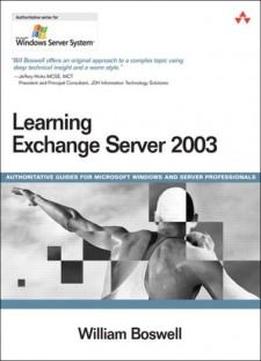
Learning Exchange Server 2003
by William Boswell /
2004 / English / CHM
19.5 MB Download
Surprisingly, the majority of organizations running Exchange are
still usingExchange 5.5 that was released in 1997. In 2003,
Microsoft suspended theirsupport of 5.5. Companies are now starting
to upgrade and they will upgradeto 2003.Most sys admins who call
themselves "Exchange" admins have never reallyworked with Exchange
servers before. And for them, most of the books onthe market assume
they have a basic understanding of Exchange and thereforejump right
into a feature-based approach for Exchange 2003. Bill
Boswellrecognized this and created a book to teach sys admins the
fundamentals ofExchange 2003: How does it work? How do I get the
most out of it? How do Ifix it if it breaks? He introduces the
material at the right level, getting thereader to do something
useful quickly, without patronizing the reader with a lotof fluff.
The chapters get readers up and running in a test environment,
thenexpose readers to layers of detail as they progress through a
topic andultimately get them ready for a real-world deployment or a
managementchallenge. Bill makes a point to cover Outlook, Eudora
and other e-mailclients. And he is not afraid to suggest third
party products when he believesthey will work more efficiently.
Surprisingly, the majority of organizations running Exchange are
still usingExchange 5.5 that was released in 1997. In 2003,
Microsoft suspended theirsupport of 5.5. Companies are now starting
to upgrade and they will upgradeto 2003.Most sys admins who call
themselves "Exchange" admins have never reallyworked with Exchange
servers before. And for them, most of the books onthe market assume
they have a basic understanding of Exchange and thereforejump right
into a feature-based approach for Exchange 2003. Bill
Boswellrecognized this and created a book to teach sys admins the
fundamentals ofExchange 2003: How does it work? How do I get the
most out of it? How do Ifix it if it breaks? He introduces the
material at the right level, getting thereader to do something
useful quickly, without patronizing the reader with a lotof fluff.
The chapters get readers up and running in a test environment,
thenexpose readers to layers of detail as they progress through a
topic andultimately get them ready for a real-world deployment or a
managementchallenge. Bill makes a point to cover Outlook, Eudora
and other e-mailclients. And he is not afraid to suggest third
party products when he believesthey will work more efficiently.











